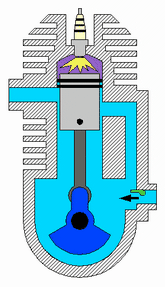Crankcase
Crankcase is a fundamental component of internal combustion engines and serves as the housing for the crankshaft and other related components. It is designed to seal the bottom of the engine to prevent the leakage of oil and to keep contaminants out of the lubrication system. The crankcase plays a crucial role in the engine's ventilation system, often housing the oil pan where engine oil collects and is circulated to lubricate, cool, and clean the engine's moving parts.
Design and Function[edit | edit source]
The design of the crankcase varies significantly depending on the type and size of the engine. In most automobile engines, the crankcase is made from cast aluminum or iron and is split into two parts: the upper crankcase and the lower crankcase. The upper crankcase supports the crankshaft bearings and is bolted to the engine block, while the lower part, often referred to as the oil pan, collects and stores the engine oil.
Crankcases are designed to withstand the pressures and temperatures of the engine's operation. They often incorporate passages for oil and, in the case of two-stroke engines, fuel-air mixture. In addition to holding the oil, the crankcase also serves as a structural member of the engine, providing rigidity and support to ensure the precise alignment of the crankshaft and other components.
Ventilation[edit | edit source]
The crankcase contains a mixture of air, fuel, and combustion byproducts that can build up pressure during engine operation. To manage this, engines are equipped with a crankcase ventilation system, which removes these gases to prevent pressure buildup and potential damage. This system, known as the Positive Crankcase Ventilation (PCV) system in modern engines, also helps reduce emissions by routing the gases back into the engine's intake manifold for combustion, rather than releasing them into the environment.
Maintenance[edit | edit source]
Regular maintenance of the crankcase and its components is essential for the longevity and efficiency of an engine. This includes regular oil changes to remove contaminants that accumulate in the oil and inspection of the crankcase ventilation system to ensure it is functioning correctly. Leaks in the crankcase can lead to loss of oil and contamination of the engine, which can cause significant damage if not addressed.
Environmental Impact[edit | edit source]
The crankcase and its ventilation system play a significant role in controlling emissions from an engine. The PCV system helps to reduce the amount of unburned fuel and oil vapor released into the atmosphere, contributing to air pollution reduction efforts. Proper maintenance of the crankcase and PCV system is essential for minimizing an engine's environmental impact.
| Crankcase Resources | |
|---|---|
|
|
Search WikiMD
Ad.Tired of being Overweight? Try W8MD's physician weight loss program.
Semaglutide (Ozempic / Wegovy and Tirzepatide (Mounjaro / Zepbound) available.
Advertise on WikiMD
|
WikiMD's Wellness Encyclopedia |
| Let Food Be Thy Medicine Medicine Thy Food - Hippocrates |
Translate this page: - East Asian
中文,
日本,
한국어,
South Asian
हिन्दी,
தமிழ்,
తెలుగు,
Urdu,
ಕನ್ನಡ,
Southeast Asian
Indonesian,
Vietnamese,
Thai,
မြန်မာဘာသာ,
বাংলা
European
español,
Deutsch,
français,
Greek,
português do Brasil,
polski,
română,
русский,
Nederlands,
norsk,
svenska,
suomi,
Italian
Middle Eastern & African
عربى,
Turkish,
Persian,
Hebrew,
Afrikaans,
isiZulu,
Kiswahili,
Other
Bulgarian,
Hungarian,
Czech,
Swedish,
മലയാളം,
मराठी,
ਪੰਜਾਬੀ,
ગુજરાતી,
Portuguese,
Ukrainian
Medical Disclaimer: WikiMD is not a substitute for professional medical advice. The information on WikiMD is provided as an information resource only, may be incorrect, outdated or misleading, and is not to be used or relied on for any diagnostic or treatment purposes. Please consult your health care provider before making any healthcare decisions or for guidance about a specific medical condition. WikiMD expressly disclaims responsibility, and shall have no liability, for any damages, loss, injury, or liability whatsoever suffered as a result of your reliance on the information contained in this site. By visiting this site you agree to the foregoing terms and conditions, which may from time to time be changed or supplemented by WikiMD. If you do not agree to the foregoing terms and conditions, you should not enter or use this site. See full disclaimer.
Credits:Most images are courtesy of Wikimedia commons, and templates, categories Wikipedia, licensed under CC BY SA or similar.
Contributors: Prab R. Tumpati, MD




